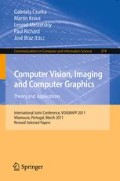Abstract
We propose a framework for stereo matching that exploits the similarities between protein sequence alignment in bioinformatics and image pair correspondence in computer vision. This bioinformatics-motivated approach is based on dynamic programming, which provides versatility and low complexity. In addition, the protein alignment analogy inspired the design of a meaningfulness graph which predicts the validity of stereo matching according to image overlap and pixel similarity. Finally, we present a technique for automatic parameter estimation which makes our system suitable for uncontrolled environment. Experiments conducted on a standard benchmark dataset, image pairs with different resolutions and distorted images validate our approach and support the proposed analogy between computer vision and bioinformatics.
Access this chapter
Tax calculation will be finalised at checkout
Purchases are for personal use only
Preview
Unable to display preview. Download preview PDF.
References
Scharstein, D., Szeliski, R.: A taxonomy and evaluation of dense two-frame stereo correspondence algorithms. International Journal of Computer Vision 47(1), 7–42 (2002)
Lazaros, N., Sirakoulis, G.C., Gasteratos, A.: Review of Stereo Vision Algorithms: From Software to Hardware. International Journal of Optomechatronics 2(4), 435–462 (2008)
MacLean, W.J., Sabihuddin, S., Islam, J.: Leveraging cost matrix structure for hardware implementation of stereo disparity computation using dynamic programming. Computer Vision and Image Understanding (2010) (in press )
Needleman, S.B., Wunsch, C.D.: A general method applicable to the search for similarities in the amino acid sequence of two proteins. Journal of Molecular Biology 48(3), 443–453 (1970)
Baker, H., Binford, T.: Depth from edge and intensity based stereo. In: IJCAI, vol. 81, pp. 631–636 (1981)
Ohta, Y., Kanade, T.: Stereo by intra- and interscanline search using dynamic programming. IEEE TPAMI 7(2), 139–154 (1985)
Geiger, D., Ladendorf, B., Yuille, A.: Occlusions and binocular stereo. In: European Conference on Computer Vision, pp. 425–433 (1992)
Belhumeur, P.N.: A Bayesian approach to binocular stereopsis. International Journal of Computer Vision 19(3), 237–260 (1996)
Cox, I.J., Hingorani, S.L., Rao, S.B., Maggs, B.M.: A maximum likelihood stereo algorithm. Computer Vision and Image Understanding 63(3), 542–567 (1996)
Torr, P.H.S., Criminisi, A.: Dense stereo using pivoted dynamic programming. Image and Vision Computing 22(10), 795–806 (2004)
Bobick, A.F., Intille, S.S.: Large occlusion stereo. International Journal of Computer Vision 33(3), 181–200 (1999)
Veksler, O.: Stereo correspondence by dynamic programming on a tree. In: Computer Vision and Pattern Recognition, San Diego, CA, USA (2005)
Deng, Y., Lin, X.: A Fast Line Segment Based Dense Stereo Algorithm Using Tree Dynamic Programming. In: Leonardis, A., Bischof, H., Pinz, A. (eds.) ECCV 2006. LNCS, vol. 3953, pp. 201–212. Springer, Heidelberg (2006)
Forstmann, S., Kanou, Y., Ohya, J., Thuering, S., Schmitt, A.: Real-Time Stereo by using Dynamic Programming. In: Computer Vision and Pattern Recognition Workshop, Washington, DC, USA (2004)
Wang, L., Liao, M., Gong, M., Yang, R., Nistér, D.: High-quality real-time stereo using adaptive cost aggregation and dynamic programming. In: 3D Data Processing, Visualization and Transmission, Chapel Hill, USA (2006)
Salmen, J., Schlipsing, M., Edelbrunner, J., Hegemann, S., Lueke, S.: Real-time stereo vision: making more out of dynamic programming. In: International Conference on Computer Analysis of Images and Patterns, Münster, Germany (2009)
Dayhoff, M.O., Eck, R.V., Chang, M.A., Sochard, M.R.: Atlas of Protein Sequence and Structure, National Biomedical Research Foundation, Silver Spring, Maryland (1965)
Altschul, S.F., Madden, T.L., Schäffer, A.A., Zhang, J., Zhang, Z., Miller, W., Lipman, D.J.: Gapped BLAST and PSI-BLAST: a new generation of protein database search programs. Nucleic Acids Research 25, 3389–3402 (1997)
Mackey, A.J., Haystead, T.A., Pearson, W.R.: Getting more from less: algorithms for rapid protein identification with multiple short peptide sequences. Molecular and Cellular Proteomics 1(2), 139–147 (2002)
Leinonen, R., Diez, F.G., Binns, D., Fleischmann, W., Lopez, R., Apweiler, R.: UniProt Archive. Bioinformatics 20, 3236–3237 (2004)
Henikoff, S., Henikoff, J.: Amino acid substitution matrices from protein blocks. Proceedings of the National Academy of Sciences 89, 10915–10919 (1992)
Higgins, D., Thompson, J., Gibson, T., Thompson, J.D., Higgins, D.G., Gibson, T.J.: CLUSTAL W: improving the sensitivity of progressive multiple sequence alignment through sequence weighting, position-specific gap penalties and weight matrix choice. Nucleic Acids Research 22, 4673–4680 (1994)
Notredame, C., Higgins, D., Heringa, J.: T-Coffee: A novel method for multiple sequence alignments. Journal of Molecular Biology 302, 205–217 (2000)
Edgar, R.C.: MUSCLE: a multiple sequence alignment method with reduced time and space complexity. BMC Bioinformatics 5, 113 (2004)
Lassmann, T., Sonnhammer, E.L.L.: Kalign - an accurate and fast multiple sequence alignment algorithm. BMC Bioinformatics 6, 298 (2005)
Karlin, S., Altschul, S.F.: Methods for assessing the statistical significance of molecular sequence features by using general scoring schemes. Proceedings of the National Academy of Sciences 87, 2264–2268 (1990)
Pearson, W.R.: Empirical statistical estimates for sequence similarity searches. Journal of Molecular Biology 276, 71–84 (1998)
Rost, B.: Twilight zone of protein sequence alignments. Protein Engineering 12(2), 85–94 (1999)
Scharstein, D., Szeliski, R.: High-accuracy stereo depth maps using structured light. In: IEEE Computer Society Conference on Computer Vision and Pattern Recognition, vol. 1, pp. 195–202 (2003)
Mühlmann, K., Maier, D., Hesser, J., Männer, R.: Calculating Dense Disparity Maps From Color Stereo Images, An Efficient Implementation. International Journal of Computer Vision 47(3), 78–88 (2002)
Klaus, A., Sormann, M., Karner, K.: Segment-based stereo matching using belief propagation and a self-adapting dissimilarity measure. In: ICPR, vol. 3, pp. 15–18 (2006)
Dayhoff, M.O.: Atlas of Protein Sequence and Structure. Suppl. 3, National Biomedical Research Foundation, Silver Spring, Maryland (1978)
International Human Genome Sequencing Consortium: Initial sequencing and analysis of the human genome. Nature 409, 860–921 (2001)
Author information
Authors and Affiliations
Editor information
Editors and Affiliations
Rights and permissions
Copyright information
© 2013 Springer-Verlag Berlin Heidelberg
About this paper
Cite this paper
Martinez-del-Rincon, J., Thevenon, J., Dieny, R., Nebel, JC. (2013). Bioinformatics-Motivated Approach to Stereo Matching. In: Csurka, G., Kraus, M., Mestetskiy, L., Richard, P., Braz, J. (eds) Computer Vision, Imaging and Computer Graphics. Theory and Applications. VISIGRAPP 2011. Communications in Computer and Information Science, vol 274. Springer, Berlin, Heidelberg. https://doi.org/10.1007/978-3-642-32350-8_11
Download citation
DOI: https://doi.org/10.1007/978-3-642-32350-8_11
Publisher Name: Springer, Berlin, Heidelberg
Print ISBN: 978-3-642-32349-2
Online ISBN: 978-3-642-32350-8
eBook Packages: Computer ScienceComputer Science (R0)

